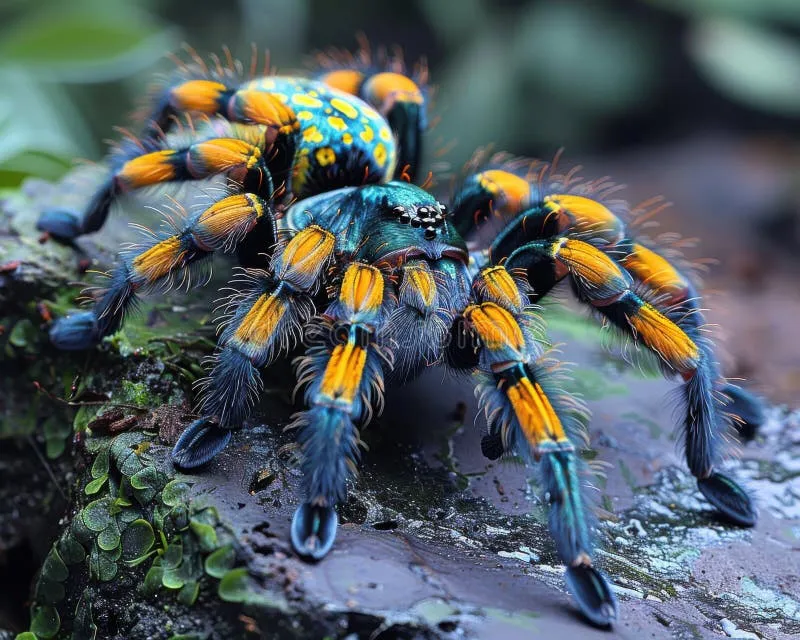What are Coloured Tarantulas?
Coloured tarantulas, a captivating group within the diverse world of arachnids, are celebrated for their stunning hues and patterns. These fascinating creatures, belonging to the Theraphosidae family, aren’t just spiders; they are living works of art. Their vibrant colours, ranging from deep blues and fiery reds to sunny yellows and regal purples, have made them highly sought-after pets and subjects of scientific curiosity. But what truly defines a coloured tarantula, and what sets them apart from their less flamboyant cousins? Delving into the world of coloured tarantulas reveals a blend of natural beauty, intricate biology, and the challenges of conservation. These spiders are more than just pets; they are a testament to the wonders of evolution, each colour serving a purpose in their survival and reproduction. Understanding these amazing animals provides an in-depth look into the fascinating world of arachnids.
Origin and Habitat
The geographical distribution of coloured tarantulas is as diverse as their colour palettes. They originate from various regions across the globe, thriving in a wide range of habitats, from tropical rainforests to arid deserts. Their natural habitats play a crucial role in shaping their appearance and behaviour. For instance, species from humid, densely forested areas often display darker, more muted colours, providing camouflage in the shadows. Conversely, those inhabiting drier, more open environments may sport brighter, bolder hues, which can serve as a warning signal to potential predators or a means of attracting mates. These environments impact not only their coloration but also their life cycle, with humidity, temperature, and food availability being critical factors. Understanding the origin and habitat of coloured tarantulas provides essential insights into the care and conservation efforts needed to protect them in their natural environments. Each species’ habitat is a fundamental aspect of its existence, influencing everything from its physical characteristics to its ecological role, providing a clear example of evolution.
Identifying Features
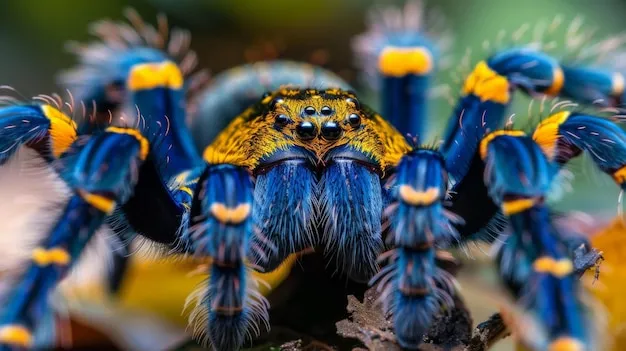
Identifying a coloured tarantula goes beyond simply spotting its vibrant colours; it involves a keen observation of various physical characteristics. The overall size and body shape are crucial indicators. Tarantulas, in general, are large, hairy spiders, but the specific dimensions vary significantly among different species. The leg span, which can range from a few inches to over a foot, is a key feature. The presence and pattern of hairs, or setae, covering the body and legs also offer valuable clues, with some species having dense, velvety coats, while others have sparser, more bristly hairs. Moreover, the shape and size of the chelicerae (mouthparts) and pedipalps (small appendages near the mouth) can aid in species identification. These subtle details, combined with the distinctive coloration, help enthusiasts and experts alike distinguish between different types of coloured tarantulas. Careful observation of these identifying features is essential for proper identification, ensuring the correct care and understanding of each unique species of coloured tarantulas.
The Colour Spectrum
The dazzling array of colours found in coloured tarantulas is a testament to the incredible diversity of nature. From the deep blues of the cobalt tarantula to the fiery reds of the Brazilian red and white, each hue serves a purpose, whether it’s for camouflage, attracting mates, or deterring predators. The colours are often produced by a combination of pigments in their exoskeleton and the way light reflects off their hairs and body surfaces. The intensity and distribution of these colours can vary depending on factors like age, sex, and environmental conditions. The vibrant colours are a defining characteristic of these spiders and a key aspect of what makes them so appealing to enthusiasts and researchers. Understanding how these colours are produced and their functions provides valuable insights into the evolutionary adaptations and ecological roles of coloured tarantulas. This colour diversity makes them a favourite among pet owners, but also makes them vulnerable, requiring careful and informed conservation strategies.
Blue Tarantulas
Blue tarantulas, like the vibrant cobalt tarantula, are among the most sought-after species due to their stunning, electric blue coloration. This striking hue is often most intense in the juveniles and can fade slightly as they mature. The blue coloration is not a result of pigmentation, but rather structural coloration, which is caused by the way light interacts with the microscopic structures on their hairs and exoskeleton. These tarantulas are typically found in the tropical regions of Southeast Asia. They are known for their relatively docile temperament, making them popular choices for beginner tarantula keepers. However, like all tarantulas, they possess venom and should be handled with caution. The popularity of blue tarantulas underscores the fascination with the unique beauty and striking colour variations found in the coloured tarantula world, but it also highlights the need for responsible pet ownership and conservation to ensure their survival in their natural habitats. Owning a blue tarantula provides a unique opportunity to witness the beauty of these creatures.
Red Tarantulas
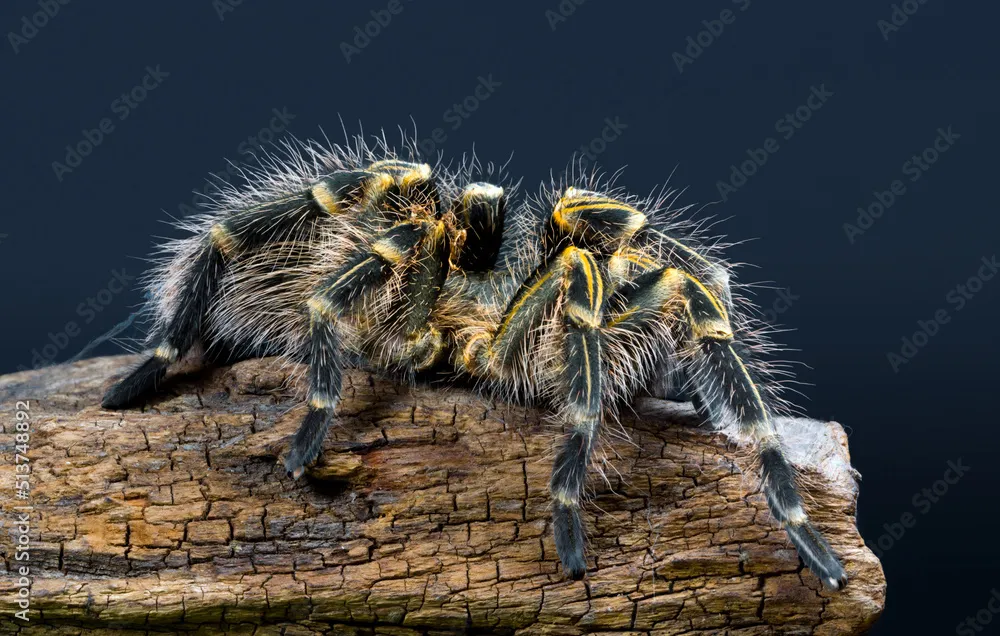
Red tarantulas, with their fiery and sometimes contrasting colours, captivate with their boldness. These species, such as the Brazilian red and white, exhibit shades of red, orange, and sometimes white or black. This vibrant colour palette often serves as a warning signal, a form of aposematism, deterring potential predators. These tarantulas are frequently found in various environments, with their colours adapting to suit the habitat. The red coloration is usually the result of specific pigments, often carotinoids, that the tarantulas obtain through their diet. The intensity of the red hue can vary based on factors like age, diet, and environmental conditions. Like other coloured tarantulas, the red species require careful attention to their environmental needs, including appropriate temperature, humidity, and diet, to ensure their well-being and to help them maintain their striking colours. They represent a blend of beauty and biological adaptation, offering an intriguing glimpse into the natural world, but also reminding us of the delicate balance of ecosystems.
Yellow Tarantulas
Yellow tarantulas, with their sunny and bright appearance, offer a cheerful contrast to the more subdued colours of some other species. Found in various environments, from tropical forests to arid regions, these tarantulas often use their yellow hues as camouflage or to blend with their surroundings. The coloration is often due to specific pigments. These tarantulas need proper care and environmental conditions to thrive and maintain their vibrant colours. The dietary intake and the enclosure’s conditions can affect the colour intensity. They provide a vivid example of nature’s palette, drawing the attention of both enthusiasts and researchers. Maintaining their habitat is crucial to ensure their survival. The conservation of yellow tarantulas is essential, as habitat loss and the pet trade can impact their populations, emphasizing the need for responsible pet ownership.
Purple Tarantulas
Purple tarantulas are highly sought-after for their regal and unique coloration, which ranges from lavender to deep violet. This stunning hue often results from structural coloration, similar to blue tarantulas, as well as the presence of specific pigments. These tarantulas are found in specific regions, making them an interesting subject of research. Their coloration can vary depending on several factors, including their age, diet, and environment. The rarity and beauty of purple tarantulas make them a prized addition to any collection, but it is crucial to understand their needs to ensure their health and well-being. Maintaining a proper environment, including correct humidity and temperature levels, is vital for their care. Conservation efforts are essential to protect their natural habitats. The purple tarantulas’ existence contributes to the biodiversity and beauty of the coloured tarantula world.
Care and Maintenance

Caring for coloured tarantulas demands attention to detail and a deep understanding of their specific needs. Key aspects of maintenance include habitat setup, feeding, humidity, and temperature regulation. Creating an environment that mimics their natural habitat is crucial for their health and longevity. This includes providing appropriate substrates, hiding places, and maintaining optimal levels of humidity and temperature. Regular feeding with a varied diet of insects is also essential. The care requirements vary based on the species, with some needing higher humidity and temperature than others. Understanding the specific care needs of each species and providing a suitable environment are essential aspects of responsible tarantula ownership. This also includes regular checks for health and well-being to ensure they are thriving in captivity. Such knowledge helps ensure their comfort and helps prevent their death, allowing these creatures to live a long life.
Enclosure Setup
The enclosure setup is the foundation of proper care for coloured tarantulas. The size of the enclosure must accommodate the tarantula’s size and growth potential. Appropriate substrate, such as coconut fiber or peat moss, is essential for maintaining humidity and providing a burrowing medium. It should be deep enough for the species to burrow. Decorating the enclosure with hiding places like cork bark, artificial plants, or other decorations, will make the tarantula feel secure. Ventilation is also critical to prevent mold and ensure the tarantula’s health. It’s also essential to provide a shallow water dish for hydration. The specifics of the enclosure setup, including the size and type of substrate, and decor, vary depending on the specific species and their natural habitat requirements. Careful attention to these details will help ensure a comfortable and healthy environment for your coloured tarantula, ensuring the pet’s survival and life quality.
Feeding and Diet
Feeding coloured tarantulas requires providing a nutritious and varied diet that mimics their natural feeding habits. The diet typically consists of live insects, such as crickets, mealworms, and roaches. The size and quantity of food depend on the tarantula’s size, age, and species. It is important to avoid overfeeding to prevent obesity and other health problems. It is also essential to ensure the insects are gut-loaded with nutritious foods before feeding them to your tarantula. Regular feeding, usually once or twice a week for adults, is sufficient. Always remove uneaten food to prevent the buildup of mold and bacteria. Water should also be readily available, usually in the form of a shallow water dish. A proper diet and consistent feeding habits are essential for the health and longevity of coloured tarantulas. Careful attention to diet and feeding practices is crucial for their well-being, making them thrive.
Humidity and Temperature
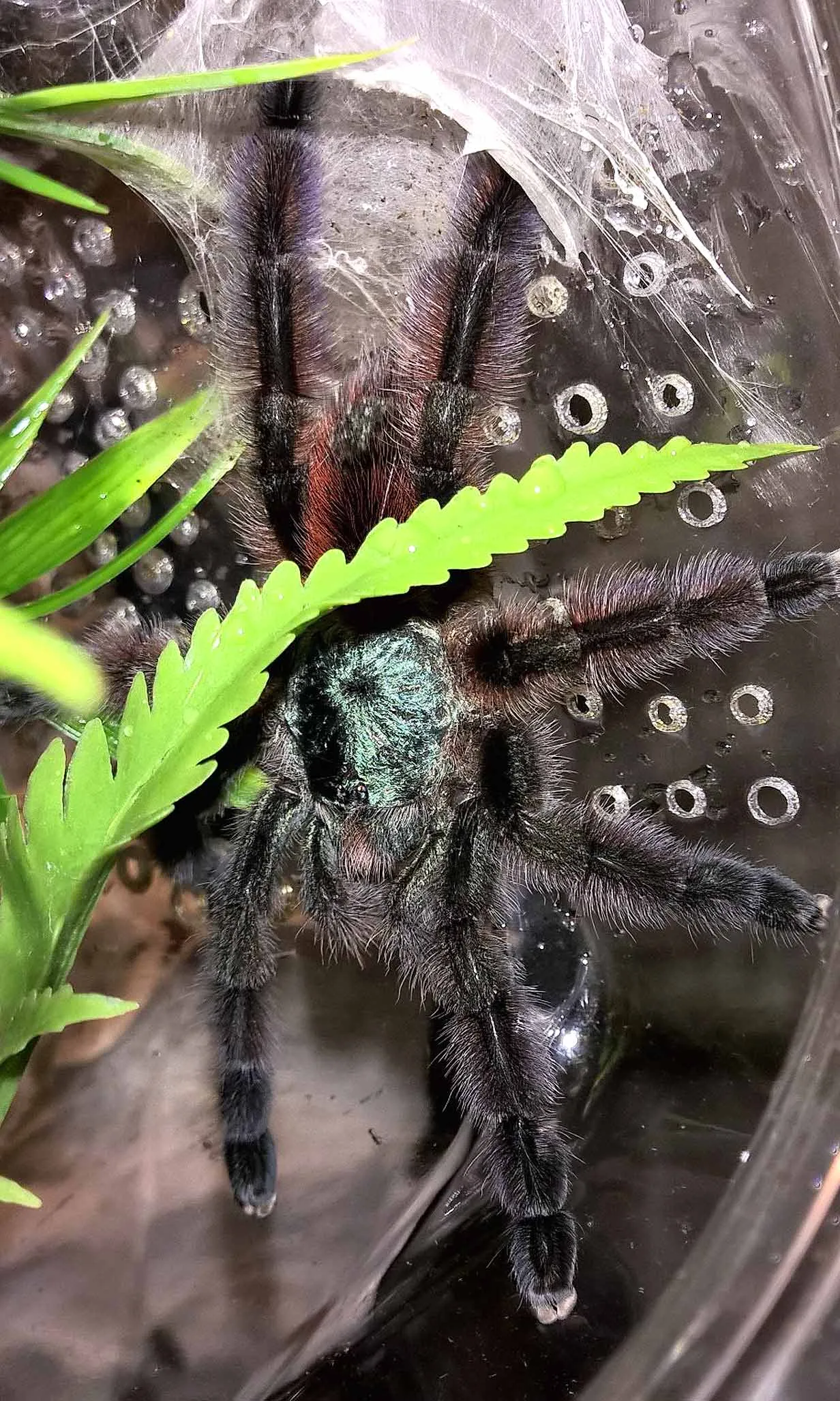
Maintaining the right levels of humidity and temperature is vital for the health and well-being of coloured tarantulas. Different species require specific environmental conditions to thrive, with some requiring higher humidity and warmth than others. Monitoring the temperature with a thermometer and the humidity with a hygrometer will help in creating a safe environment. Regular misting, the use of a water dish, and appropriate ventilation help maintain the necessary humidity levels. Substrates such as coconut fiber, also help retain moisture. Use a heat source like a heat mat or ceramic heat emitter to provide consistent warmth if required. The proper balance of temperature and humidity is essential for the tarantula to molt and to prevent health issues. Careful management of the environment will ensure the tarantula’s health and happiness. Proper environment conditions are a fundamental part of owning and protecting coloured tarantulas.
Tarantula Temperament
Understanding the temperament of coloured tarantulas is crucial for safe and responsible pet ownership. Tarantula temperaments vary greatly, with some species being more docile and others more defensive. Factors like species, age, and individual personality influence their behaviour. Some tarantulas are more prone to flicking urticating hairs, a defence mechanism that can cause skin irritation, while others may attempt to bite when threatened. Learning about the specific temperament of your tarantula is important. Observe their behaviour in the enclosure, paying attention to body posture and warning signs. Avoid sudden movements and loud noises. A calm approach will reduce the chances of defensive behaviour. Knowing your tarantula’s behaviour can provide a safe environment.
Handling and Interaction
Handling coloured tarantulas should be approached with caution and respect. While some tarantulas are docile enough to handle, it is always best to minimize handling to reduce stress. If handling is necessary, always do so close to the ground, to prevent injury from a fall. When handling, be gentle and avoid sudden movements. Use a gentle approach when interacting with your tarantula. Always wash your hands before and after handling to prevent contamination. Learn about the specific species’ temperament to understand their behaviour. The safety of both the tarantula and the handler is the priority. Never force a tarantula to be handled. A safe and informed approach promotes a positive relationship with your pet, making the ownership a better experience.
Potential Hazards
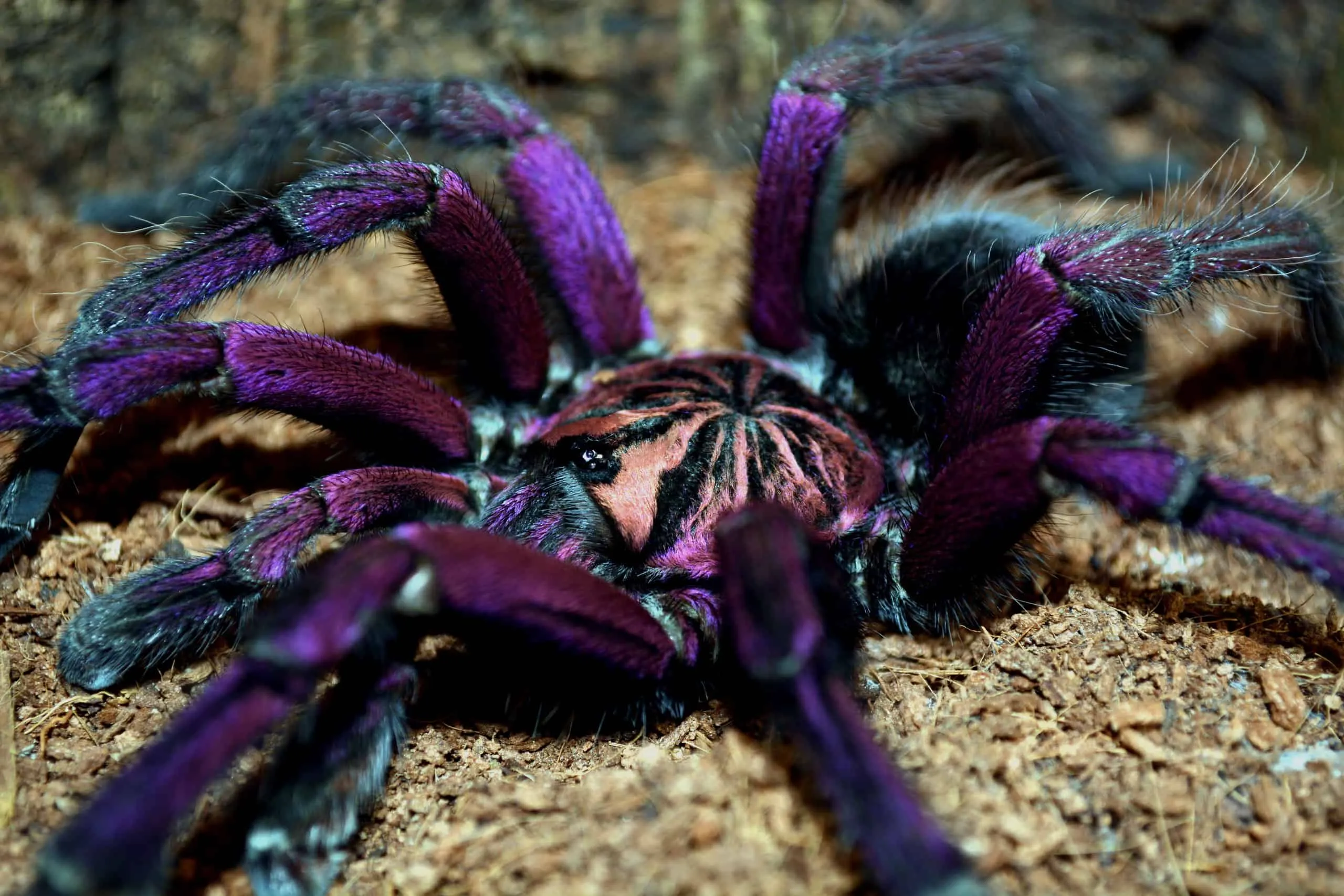
Several potential hazards are associated with keeping coloured tarantulas, which require careful consideration. One key hazard is the risk of being bitten, which, while rarely fatal, can be painful and cause localized symptoms such as swelling and redness. Another risk is the urticating hairs, which can be flicked by some tarantula species as a defence mechanism. These hairs can cause skin irritation and, if inhaled, respiratory issues. Proper ventilation and handling techniques can reduce these risks. Also, ensure the enclosure is secure to prevent escapes. Be aware of the potential for allergic reactions. Handling and caring for coloured tarantulas involve some risks. Understanding these hazards and taking necessary precautions can ensure a safe and enjoyable experience. Safety is paramount in dealing with these creatures, ensuring both the pet owner and the tarantula are safe and comfortable.
Conservation and Availability
The conservation status and availability of coloured tarantulas vary widely, with some species being more threatened than others. Factors such as habitat loss, the pet trade, and over-collection pose significant risks. Many tarantula species are not yet evaluated by conservation organizations, and those that are, often face pressure from habitat loss and overexploitation. Responsible pet ownership involves being aware of the conservation status of your tarantula. Purchase tarantulas from reputable breeders who prioritize ethical sourcing and avoid wild-caught specimens. Support conservation efforts that protect their habitats. Conservation ensures the survival of these fascinating creatures and protects their natural environments. It provides the knowledge needed to keep them safe and happy in the long run. By understanding and supporting the conservation of coloured tarantulas, we can help ensure that these beautiful creatures continue to thrive for future generations.
